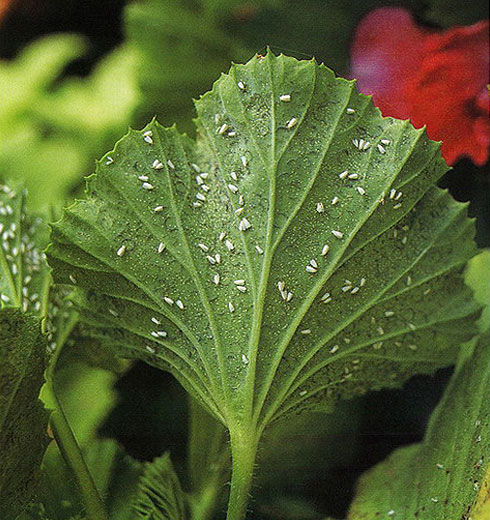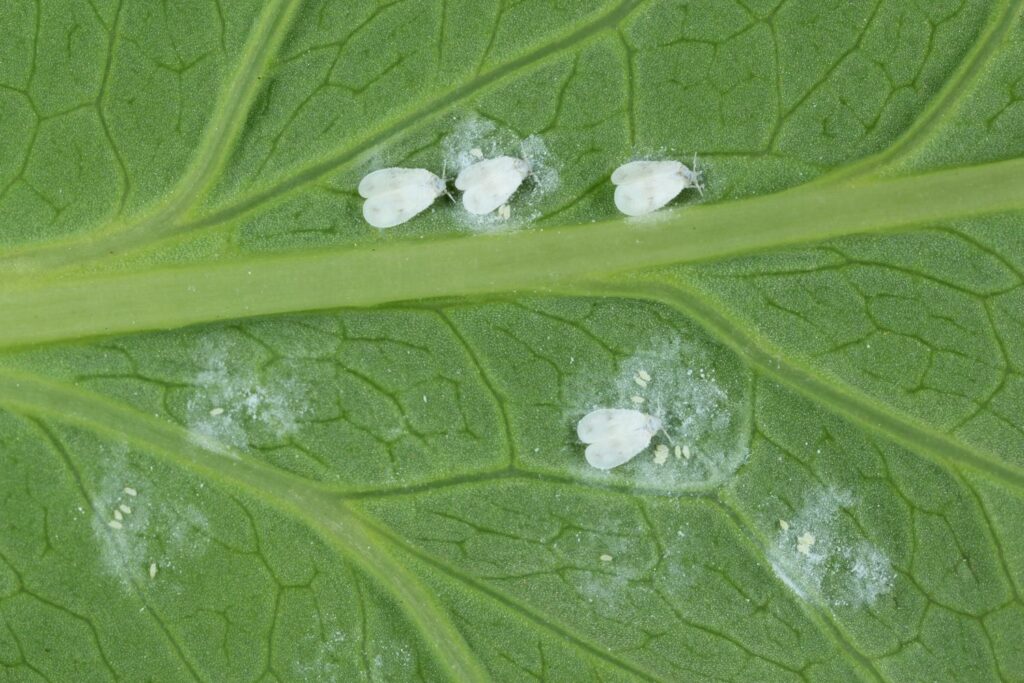
White Fly
Bemisia Tabaci
Pathogène :
Insect
Type:
Risque:
HIGH
Mosca blanca


QUI EN EST LA CAUSE ?
The whitefly, belonging to the Aleyrodidae family, is a common pest that affects a wide variety of plants, including geraniums. These small insects, just a few millimeters in length, are characterized by their white wings and their appearance similar to that of a small fly. Whiteflies feed on plant sap and produce a sticky substance known as honeydew, which can promote the growth of fungi such as black mold. In addition, these pests can transmit viruses and diseases to plants, which aggravates the damage caused by their feeding.
SYMPTÔMES
The disease caused by whitefly in geranium manifests itself mainly in the deformation of the leaves and the general weakening of the plant. Symptoms include the presence of yellow or silver Taches on the tops of the leaves, caused by sucking the plant's sap. In addition, you can observe the presence of whiteflies on the underside of the leaves, where they feed and lay their eggs, and the accumulation of honeydew and black mold on the surface of the plant.
TEMPÉRATURE ET HUMIDITÉ
25°C - 30°C
50% - 70%
VOIES DE TRANSMISSION
Direct contact, transport by wind, transport by infected plant materials.
TRAITEMENTS
Traitements chimiques
• ABAMECTIN 0.0015% + PYRETHRINS 0.02% [AL] P/V
• RAPESEAL OIL 0.825% + PYRETHRINS 0.018% [AL] P/V
• RAPE OIL 1.53% [AL] P/V
• RAPE OIL 1.69% ( ) [AL] P/V
• RAPE OIL 77.7% [EC] P/V
• RAPE OIL 82.53% + PYRETHRINS 0.459% [EC] P/V
• RAPE OIL 848.24 g/l [EC] P/V
• ORANGE OIL 6% [SL] P/V
• ORANGE OIL 60g/L [ME] P/S
• ACETAMIPRID 0.005% [AL] P/V
• ACETAMIPRID 20% [SG] P/P
• ACETAMIPRID 20% [SP] P/P
• AZADIRACTIN 1% (AS AZADIRACTIN A) [EC] P/V
• Azadirachtin 2.6% (AS AZADIRACTIN A) [EC] P/V
• SULFUR 0.4% + POTASSIUM SALTS OF UNSATURATED FATTY ACIDS C7-C18 & C18 (CAS [67701-09-1] 1% [AL] P/V
• BUPROFEZIN 25% [SC] P/V
• CYPERMETHRIN 10% [EC] P/V
• CYPERMETHRIN 10% [EW] P/V
• CYPERMETHRIN 5% [EC] P/V
• CYPERMETHRIN 50% [EC] P/V
• DELTAMETHRIN 1.5% [EW] P/V
• DELTAMETHRIN 1.57% [SC] P/V
• DELTAMETHRIN 10% [EC] P/V
• DELTAMETHRIN 2.5% [EC] P/V
• DELTAMETHRIN 2.5% [EW] P/V
• PHENPIROXIMATE 5.12% [SC] P/V
• FLUPIRADIFURONE 0.008% [AL] P/V
• FLUPYRADIFURONE 20% [SL] P/V
• LAMBDA CYHALOTHRIN 0.0015% [ME] P/V
• LAMBDA CYHALOTHRIN 1.5% [CS] P/V
• LAMBDA CYHALOTHRIN 10% [CS] P/V
• LAMBDA CYHALOTHRIN 2.5% [WG] P/P
• LAMBDA CYHALOTHRIN 5% [EG] P/P
• PYRETHRINS 1.9% [EC] P/V
• PYRETHRINS 4.65% (as pyrethrum extract) [EC] P/V
• PYRETHRINS 4% (PYRETHHRINE EXTR.) [EC] P/V
• PYRIDABEN 10% [SC] P/V
• PYRIPROXIFEN 10% [EC] P/V
• POTASSIUM SALTS OF UNSATURATED FATTY ACIDS C7-C18 & C18 (CAS [67701-09-1] 515g/L [SL] P/V
• POTASSIUM SALTS OF UNSATURATED FATTY ACIDS C7-C18 & C18 10.2g/L [AL] P/V
• POTASSIUM SALTS OF FATTY ACIDS C14-C20 48% [EW] P/V
• POTASSIUM SALTS OF VEGETABLE FATTY ACIDS 13.04% [SL] P/V
• SPIROMESIFEN 24% [SC] P/V
• SULFOXAFLOR 12% [SC] P/V
• ADHESIVE TRAPS
• CHROMATIC TRAPS
Traitements autorisés en agriculture biologique
• RAPESEAL OIL 0.825% + PYRETHRINS 0.018% [AL] P/V
• RAPE OIL 1.53% [AL] P/V
• RAPE OIL 1.69% ( ) [AL] P/V
• RAPE OIL 77.7% [EC] P/V
• RAPE OIL 82.53% + PYRETHRINS 0.459% [EC] P/V
• RAPE OIL 848.24 g/l [EC] P/V
• ORANGE OIL 6% [SL] P/V
• ORANGE OIL 60g/L [ME] P/S
• AZADIRACTIN 1% (AS AZADIRACTIN A) [EC] P/V
• Azadirachtin 2.6% (AS AZADIRACTIN A) [EC] P/V
• SULFUR 0.4% + POTASSIUM SALTS OF UNSATURATED FATTY ACIDS C7-C18 & C18 (CAS [67701-09-1] 1% [AL] P/V
• LAMBDA CYHALOTHRIN 0.0015% [ME] P/V
• LAMBDA CYHALOTHRIN 1.5% [CS] P/V
• LAMBDA CYHALOTHRIN 10% [CS] P/V
• LAMBDA CYHALOTHRIN 2.5% [WG] P/P
• LAMBDA CYHALOTHRIN 5% [EG] P/P
• PYRETHRINS 1.9% [EC] P/V
• PYRETHRINS 4.65% (as pyrethrum extract) [EC] P/V
• PYRETHRINS 4% (PYRETHHRINE EXTR.) [EC] P/V
• POTASSIUM SALTS OF UNSATURATED FATTY ACIDS C7-C18 & C18 (CAS [67701-09-1] 515g/L [SL] P/V
• POTASSIUM SALTS OF UNSATURATED FATTY ACIDS C7-C18 & C18 10.2g/L [AL] P/V
• POTASSIUM SALTS OF FATTY ACIDS C14-C20 48% [EW] P/V
• POTASSIUM SALTS OF VEGETABLE FATTY ACIDS 13.04% [SL] P/V
• ADHESIVE TRAPS
• CHROMATIC TRAPS
Traitements biologiques
• AMBLYDROMALUS LIMONICUS
• AMBLYSEIUS SWIRSKII
• BEAUVERIA BASSIANA (STRAIN ATCC 74040) 2.3% (2.3X10E7 VIABLE SPORES/ML) [OD] P/V
• BEAUVERIA BASSIANA strain PPRI 5339 8% (8 X 10E12 CFU/L) [OD] P/P
• CHRYSOPERLA CARNEA
• DELPHASTUS CATALINAE
• ENCARSIA FORMOSA
• ERETMOCERUS EREMICUS
• HETERORHABDITIS BACTERIOPHORA
• ISARIA FUMOSOROSEA (Apopka 97 strain) 20% [WG] P/P
• METARHIZIUM BRUNNEUM strain Ma 43 10.5% [OD] P/V
• PAECILOMYCES FUMOSOROSEUS (STRAIN FE 9901) 18% (2 X 10 E9 CFU/G) [WP] P/P
• TRANSEIUS MONTDORIENSIS
Recommandations
To prevent whitefly infestation in geranium, it is important to regularly inspect the plants and take preventative measures, such as manually removing the insects and using sticky traps. It is also recommended to encourage the presence of insects that are natural predators of whiteflies, such as ladybugs, and avoid excessive use of nitrogen fertilizers, which can favor the reproduction of these pests.
TRAITEMENTS
Remèdes maison
There are no home treatments
Alliés naturels
Traitements chimiques
There are no treatments for this disease. Treatments are directed at the insect vectors that transmit it. See insect treatments.
RECOMMANDATIONS
- Check the back of the leaves frequently, especially in dry weather.
- Spray water on the leaves to increase humidity and prevent them from settling.
- Keep plants healthy with good watering and adequate light.
- If you see cobwebs or damage, clean the leaves with a damp cloth or pressurized water.
- Use potassium soap or neem oil every few days until they disappear.
Plantes répulsives
Rosemary, Dill, Coriander
PRODUITS RECOMMANDÉS
*Les traitements recommandés sont des recommandations basées sur les bases de données des autorités et ne remplacent en aucun cas les lignes directrices établies par la législation de chaque pays.
*Les produits présentés sont des recommandations et ne sont pas nos propres produits. En tant qu'associés Amazon, nous gagnons des revenus grâce aux achats de produits recommandés.





















